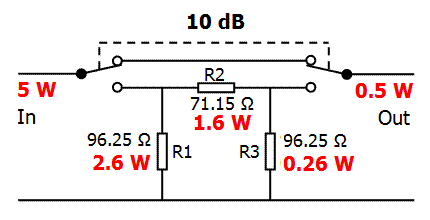PA1B Power Attenuator Calculator
The use of this unique PA1B Power Attenuator Calculator enables you, to design a very accurate power attenuator for any power you want. So you can reduce the power of you QRP set from 5 watts down to QRPp level with out modifying the set.
A power attenuator is an attenuator, which is suitable for a much higher input power than is usual, for an simple Pi-type attenuator.
All attenuators on this site are developed with this calculator. The three fundamental resistors that form a Pi-type power attenuator, are each composed of a number of resistors in parallel. The power is distributed over the resistors.
The higher the power, the more resistors are required. I developed the calculator for attenuator sections of 1 dB, 2 dB, 3 dB, 7 dB, 10 dB or 20 dB.
E12-series
The PA1B power attenuator calculator enables you to take good available resistors with a modest power, from the E12-series. Build your attenuators with carbon resistors or metal film resistors. They are induction free. Don’t use wire wound resistors. The PA1B power attenuator calculator will calculate the resistors effortlessly. The calculator computes the number of resistors and the values of the resistors, which are based on the E12-series values. Due to the good availability and your own choice of the maximum power of the resistors (e.g. 1/2 watt), you can get exactly what you want.
Derating
For a good reliability and good accuracy, the attanuators must be operated between 25 and 50 percent of their maximum power rating. It is wise to use a derating value of 25% to prevent the attanuator from over heating as specially when there is no cooling.
This means that an attenuator for a nominal input power of 5 watt from your QRP set, must be designed for a maximum input power of 20 watts. For 5 watts in CW the maximum power of the attenuator can be 10 watts.
Derating D = 25%
For a nominal input power of 5 watt
design your attenuator for a
maximum input power of 20 watts
How to use the Calculator
Enter the values of the attenuation, input power and the maximum power of the resistors in the white input fields.
Give [TAB] after each value. Use a comma as decimal indicator in all NON-English versions of Excel (thus: 0,5 for 1/2 watt)
There is no RUN button, because the spreadsheet will calculate all values immediately, each time an input value is entered or changed.
The Calculator has NO limitations on the input power or the maximum power of the resistors.
The Calculator will even work with an input power of far more than 5 watts or with resistors of 0.25W or 0.1W. hi.
Example
Design a 10 dB attenuator for an maximum input power of 5 watts, built with resistors of 1/2 watt.
(Notice that the nominal power of this attenuator will be 1.25 watt for a continues signal during accurate measurements or WSPR. The nominal power CW will be 2.5 watt)

PA1B Power Attenuator Calculator
Enter 10 followed by [TAB] for an attenuation of 10 dB.
Enter 5 [TAB] for a power of 5 watts.
Enter 0.5 [TAB] for resistors of 1/2 watt or 0,5 in non English versions of Excel.
Tip:
Use the numeric keypad for the comma or point.
When you see #### please use a comma instead of a point or the other around.
The calculator first calculates the power that is dissipated in each of the 3 compound resistors R1, R2, and R3. The power determines the number of resistors in parallel that should be used.

10 dB Attenuator for a maximum input power of 5 watt
Resistors 1/2 W

Power distribution in an attenuator
with an input power of 5 watt.
Download the PA1B Power Attenuator Calculator
Thing to consider
Nominal power versus Maximal power
- Design the attenuator for a maximal power that is four time as high as the nominal power. Derating = 25%
Tribal knowlage
- Carbon resistors loose their heat by radiating from their bodies.
- Metal film resistors loose their via their wires
Each compound resistor R1, R2 and R3, is accurately formed by a number of resistors in parallel. The higher the power, the more resistors are needed.
Rather use the link, to the latest version, but also keep a copy of the calculator on your computer.